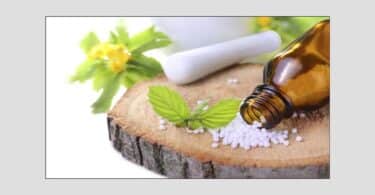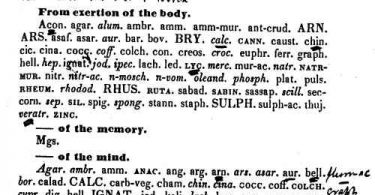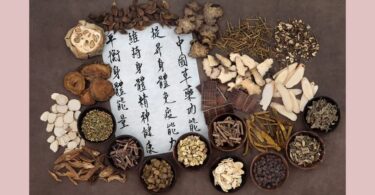“The old practitioners of medicine…. spend months in writing, hypothetically, about the impossibility of Homoeopathy, — when the placing of a few globules on the tongue would satisfy them of its truth, and make them blush for shame at their petty prejudice and idle talking!”
Dr. P. Curie

Thus these two properties are fundamentally one and the same; and they differ only as applied to health or to disease. Hence it is evident that, to know the therapeutic power of any substance, we must first know its pathogenetic power.
Our present knowledge of drugs is mostly the result of customary use or empirical trials in disease. As, however, it would be impossible to try every medicine against each disease, it is equally impossible thereby to determine their specific action. Nor, if such trials in disease were possible, could they have any more instructive effect than it would have to try the odorous or sapid qualities of bodies by applying them to the organs of smell or taste when similarly deranged. Moreover, by trying medicines in disease, not only is the immediate susceptibility, but the consequent sympathy of the organs infinitely varied, even in relation to the same substance.
‘Accordingly,’ says Hahnemann, “ the reaction of the diseased frame generally induces such complicated phenomena, that it is almost impossible to unravel them; for, either there is no change, or there follows deterioration, variation, improvement, recovery, or death, without the greatest practical genius being able to discover the precise part which the disease or the remedy may have had in the result.” — “ If to this, too, is added the incongruous and often conflicting nature of the ingredients of which remedies are generally composed, the difficulty would appear altogether insurmountable.’ 5 There is,” he says, “ no other infallible nor natural way of discovering the proper effects of medicaments on the human constitution than trying them on healthy persons, and observing what changes result from these experiments in the state of the body and mind, or what elements of artificial disease the medicaments are capable of producing.”’
Mode of Experiment to Determine These Powers
Hahnemann, accordingly, and his friends, Frantz, Hornburg, Stapf, etc, submitted themselves to a course of experiments continued during above twenty years, and their method, with little alteration, may here be given, as at once showing the great care they bestowed, and serving as an example for all who are resolved experimentally to determine the truth of Homoeopathy.
In such experiments, — as the action of each and every substance varies according to sex, age, and constitution, it is expedient to experiment on as many persons as possible, and to try each substance in various doses and under various conditions.
The essential conditions of these experiments are:
- that the experimenters be in perfect health; that they scrupulously adhere to diet which is merely nutritious, and in no way pathogenetic; that they carefully avoid the use of fermented liquors, wine, spirits, spices of every kind, coffee, strong tea, acid fruits, and all vegetables, except those of a farinaceous and mild description; that they shun all fatigue bodily and mental, all excess, and even excitement, and that they previously note every habitual symptom by which they are affected.
As to medicines, those only must be used which are genuine, pure, and of well marked action. Each must be given in a perfectly simple form, nor, during the experiment, must anything else of a medicinal kind be used.
It must be borne in mind, that some medicines act powerfully even in small doses, and others only in large ones; as well as that the torpidity and dullness, or the delicacy and susceptibility of the constitution of the person experimented upon (both generally and as to the particular medicines), must be duly considered in estimating the result, in relation to medical practice.
As, however, it is impossible, previous to experiment, to know the susceptibility or torpidity of the person experimented upon, it is right always to begin with a small dose. This may be taken every night three hours after the last meal, or every morning three hours before the first meal, and gradually increased till its action is determined. To increase such action, the dose must be more rapidly increased.
All this being done, every modification of health may fairly be noted down as resulting from the pathogenetic action of the drug employed.
It is necessary to note the time of taking the drug, upon what texture or organ it acts, at what hour the symptom chiefly shows itself, what alterations it induces, what modifications its action suffers from waking, sleeping, moving, resting, eating, drinking, moral emotions, intellectual activity, confined or open air, atmospheric changes, the different times of day, and the changes of seasons, what influence sex, temperament, moral and intellectual character, age and constitution have over it and how long it lasts.
Thoroughly to know the medicine, it should be tried both in small and large doses. The degree of reaction it causes in each should be noticed. The relation which subsists between the action of various substances should be observed and their consequent powers of diminishing, or neutralizing each other, should be investigated.
If, before the termination of any experiment, there occur any circumstance modifying its result, it must be broken off and begun anew. It will easily be understood, that, in making experiments on a healthy person, there are limits which cannot be passed without endangering life. It will be obvious that it is unnecessary to push experiments so far as to produce poisoning, consumption, cancer, or any other equally formidable affection. Where accidental cases of poisoning, for instance, have not afforded opportunities for tracing the effects produced by certain medicines, they may be deduced from the symptoms which approach most nearly to poisoning and subsequent observation of particular cases will confirm their conclusions.
The value of a Materia Medica thus constructed is evident.
It will now be seen how justly, in the course of my observations in explanation of the homoeopathic principle, similia similibus curantur, I stated that the powers of the medicaments had first been tried upon individuals in good health. This is in fact the only test which can be employed when the principle is recognized, that to cure sickness, a medicine must be administered which would produce the symptoms of that particular case in a healthy subject.
Conclusions Drawn From These Experiments
These conclusions have been:
- That all medicinal substances administered in adequate doses to healthy individuals, disturb the functions more or less in proportion to their power.
- That their action produces two series of symptoms, primary or direct, appearing soon after taking the substance, and secondary or indirect.
In the primary symptoms, each group, modified by idiosyncrasy, forms a peculiar medicinal disease. Among these symptoms, some are peculiarly characteristic of the medicament; their duration depends on the nature and quantity of the latter, and in employing them, care is taken that they correspond to the characteristics of the disease. To the primary or direct action of the medicine the secondary or indirect action succeeds, and when the former has been strong or feeble, the latter corresponds.
- The consequence of the direct action of some other substances is an alternation of symptoms of opposite character, apparently indicating oscillatory movements between the primary, direct or pathogenetic, and the secondary, indirect or curative effects, and this oscillation is perhaps only less apparent in some cases than in others.
- Substances differ as to the time of producing symptoms — in the morning, in the evening, or at night.
- In proportion to the similarity of organization, is the similarity of the pathogenetic and consequently of the curative effects of similar doses.
- Those effects are accidental, which are not found to be constant in the greater number of persons. Those are certain, which are few and nearly the same in all, and to determine this, an analysis of many cases is necessary.
- Medicaments, in their pathogenetic effects, follow fixed and eternal laws, produce certain and positive symptoms, and, when well applied, afford infallible remedial means.
Consistently with all this, Hahnemann says, “each medicament changes health in a particular manner and we are not permitted to confound one with the other. For that reason, medicinal equivalents or substitutes are in no way admissible in practice, and every medical man ought to distinguish as exactly as possible the different medicaments,” — both as causes of disease and as means of cure.
If anyone dispute the facts above stated, let him repeat the experiments, — let him try even the simplest of these. And here let me say that, in the whole history of science and art, no event has placed in so conspicuous a point of view, the contentedness of habitude, or the obstinacy of prejudice, as the fact that the old and routine practitioners of medicine do not hesitate to spend hours or days in talking, and weeks or months in writing, hypothetically, about the impossibility of Homoeopathy, — when the placing of a few globules on the tongue would satisfy them of its truth, and make them blush for shame at their petty prejudice and idle talking!
It has, indeed, been objected that, in repeating some of these experiments upon healthy individuals, one or more of the symptoms announced have not been produced. But this arises from not observing that greater doses are necessary in health than in disease, that the conditions above described must be attended to, that the more constant and characteristic effects of a medicine must be distinguished from those which are accidental and unimportant and that peculiar constitution modifies every medicinal effect. The effects produced by the same medicaments upon the patient in disease, furnish proofs of the correctness of the former experiments.
Thus, with the Materia Medica of Hahnemann, and the clinical observations of other physicians, a pharmacopoeia has been formed, which is founded on actual experience, which is considerable in extent, and which is equal to the task of relieving most of the ills which afflict humanity.
This materia medica is further distinguished from the common one by antidotes, employed to counteract or merely to modify the action of the medicines previously administered. These antidotes are either general or special. The general are such as modify or counteract the effects of many medicaments; the special, those which similarly affect particular ones. Camphor, for instance, has been found to be the antidote for a great number of medicaments, and especially for those of a vegetable kind, wine and acids for Aconite, — and so on, for other substances.
Physicians in former times, not having the same command of medicaments, nor any principle to guide them in ascertaining the effects which follow their use, fell into numerous errors, and made but slow advances. It was by chance alone they could discover true remedies. It was merely by accident that some of the virtues of Sulphur, Mercury, Quinquina, and various other substances became known.
Having accidentally discovered a specific, they could not employ it without danger to their patients, because, being administered in large doses, acting upon the diseased organs in the same manner as the disease itself, it often produced a dangerous and sometimes a fatal aggravation.
Besides, there existed no means of distinguishing the symptoms of the disease from those produced by the medicine, and consequently, no sound conclusion could be drawn from the effects of the latter upon a person suffering under disease. Hence it is evident that the only rational method of experimenting with medicines, is, as all I have now said proves, to ascertain their action upon a person in sound health.
Excerpted from Principles of Homoeopathy by Dr. Paul Francis Curie M.D – (1837).





